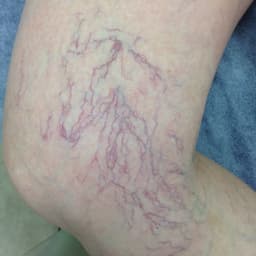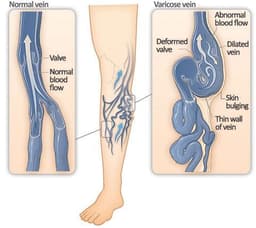Slug: varicose-veins
Summary: Varicose veins are twisted, enlarged veins. Any vein that is close to the skin's surface (superficial) can become varicosed. Varicose veins most commonly affect the veins in the legs. That's because standing and walking increase the pressure in the veins of the lower body. For many people, varicose veins and spider veins — a common, mild variation of varicose veins — are simply a cosmetic concern. For other people, varicose veins can cause aching pain and discomfort. Sometimes varicose veins lead to more-serious problems. Treatment might involve self-care measures or procedures done by a health care provider to close or remove veins.


Varicose veins are twisted, enlarged veins. Any vein that is close to the skin's surface (superficial) can become varicosed. Varicose veins most commonly affect the veins in the legs. That's because standing and walking increase the pressure in the veins of the lower body.
For many people, varicose veins and spider veins — a common, mild variation of varicose veins — are simply a cosmetic concern. For other people, varicose veins can cause aching pain and discomfort. Sometimes varicose veins lead to more-serious problems.
Treatment might involve self-care measures or procedures done by a health care provider to close or remove veins.

Varicose veins might not cause pain. Signs of varicose veins include:
When painful signs and symptoms of varicose veins occur, they might include:
Spider veins are similar to varicose veins, but they're smaller. Spider veins are found closer to the skin's surface and are often red or blue.
Spider veins occur on the legs but can also be found on the face. They vary in size and often look like a spider's web.
If you're concerned about how your veins look and feel and self-care measures haven't helped, see your health care provider.
Weak or damaged valves can lead to varicose veins. Arteries carry blood from the heart to the rest of the body. Veins return blood from the rest of the body to the heart. To return blood to the heart, the veins in the legs must work against gravity.
Muscle contractions in the lower legs act as pumps, and elastic vein walls help blood return to the heart. Tiny valves in the veins open as blood flows toward the heart, then close to stop blood from flowing backward. If these valves are weak or damaged, blood can flow backward and pool in the veins, causing the veins to stretch or twist.
The following can increase the risk of developing varicose veins:
Complications of varicose veins, although rare, can include:
Improving blood flow and muscle tone might reduce the risk of developing varicose veins. The same measures that treat the discomfort from varicose veins can help prevent them. Try the following: